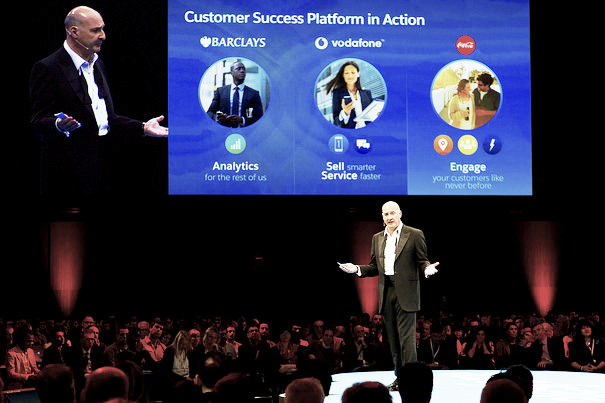Forget the keynote speakers, the 66 cloud partners, the 14,000 people who registered to attend and the million who tuned in online. The real VIPs of Salesforce World Tour London were the end customers on the high street, on the web and everywhere in between. The stars of every keynote and expert session, they were celebrated as the centre of the Salesforce universe.
The customer-centric universe
There’s nothing new in saying the customer is always right. For their next trick, customers are trying something new and becoming omni-present.
They’re at the heart of everything you do, pervading every product and process. Sporadic transactions have given way to on-going engagement and customers are enjoying personalised interactions with brands.
That’s what should be happening, anyway.
In his opening keynote, Salesforce Vice Chairman and President, Keith Block said, “The most successful companies will be the ones who put the customer at the centre of their universe.”
He went on to make the case: if you’re not doing this, your business has a problem.
The changing customer journey
So how do you re-centre your universe? It starts with the customer journey, which has taken a few surprise turns since Saleforce first hit the scene in 1999.
Once upon a time, Keith explained, managing the customer journey was a relatively simple affair. The relationship between business and customer was transactional, and neither party knew a huge amount about the other.
Then along came the cloud and things got a bit crazy. Today trillions of customer interactions take place on billions of connected devices.
With scale like that, businesses that cling to the old ways are headed for trouble.
Mind the customer gap
Customer expectations are changing, too. This generation of consumers is the first to own devices at home that run rings round the technology they use at work. They’re on social, through the cloud, on the move. If your sales teams are hampered by legacy systems, they’ll never keep up.
That’s how a technology gap becomes a chasm between you and your customers. And if you don’t start plugging the hole now, it’s only going to get bigger.
It’s predicted that by 2018 there will be 5 billion smartphones on the planet, firing off new connections. That’s a lot of new information, especially when you consider that 90% of the data that exists today was created in the past year. How will your systems cope with what comes in the next few years?
A new way of doing business: Coca-Cola
To attract this new breed of connected customer – and keep them engaged – your business needs to make decisions exactly where it matters. This rule was at the heart of Coca-Cola and Salesforce’s work to create a truly collaborative system for sales, marketing and service.
As Coca-Cola Erfrischungsgetränke AG CEO Ulrik Nehammer put it, “The most dangerous place to make a decision is in the office.”
A unified front: Vodafone
It’s not just where you sell that’s changing. You have to join up all the dots, and you have to do it right.
Vodafone’s offering has changed dramatically in the past few years, and as deal complexity has grown, so too has the importance of a unified customer experience.
For Matt Thomas, Head of Management Information and Sales Analytics at Vodafone, this means giving sales teams the right customer information from across the organisation. “Our customers don’t see different parts of Vodafone, they see Vodafone the brand.”
Plug in and play: Barclays
Of course, your sales teams have to be comfortable handling this data before they can do anything useful with it.
During Keith’s keynote we learned how Barclays is using Wave, powered by Salesforce Analytics Cloud, to give its analysts some serious business intelligence firepower – without having to bother IT every time they need to run a report.
Barclays employees can import large data files ready for manipulation on their mobile devices. In one demo we saw a dataset with 53 million(!) rows of UK census information analysed alongside some information on broker performance.
Steve Weston, CEO Mortgages at Barclays, summed up the new relationship between a customer-centric organisation and its customer nicely:
“If you know this much about me [the customer] and you can add value or you can make my life easier, I expect you to do that. And you know what? If we don’t then there are other firms that will.”
Key takeaways
- Keep the customer at the centre of your universe
- Cloud computing has created a perfect storm
- Avoid the Customer Gap by being mobile, social and agile
- Present a unified front to ensure coherent customer experience
- Democratise BI to empower your analysts







